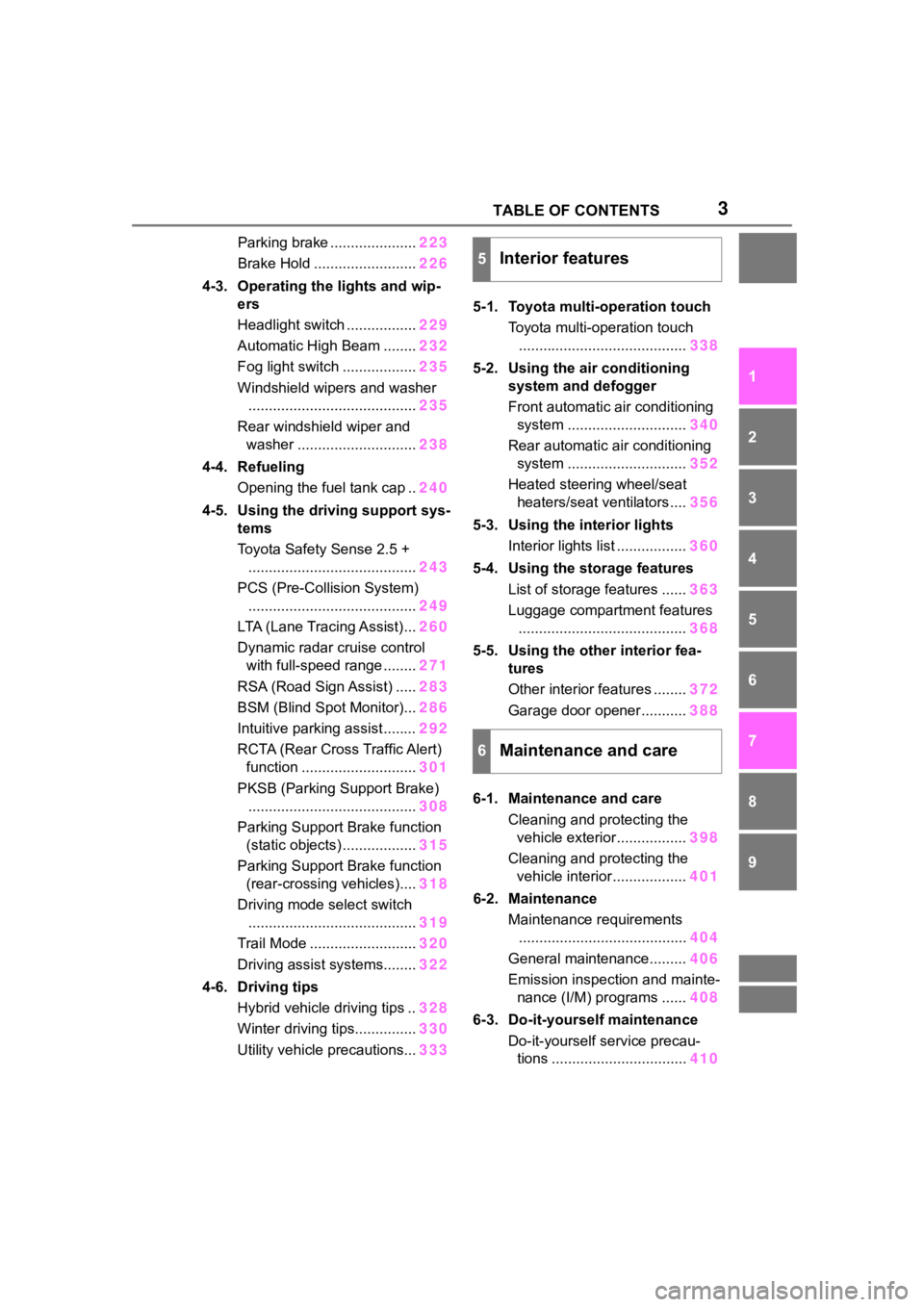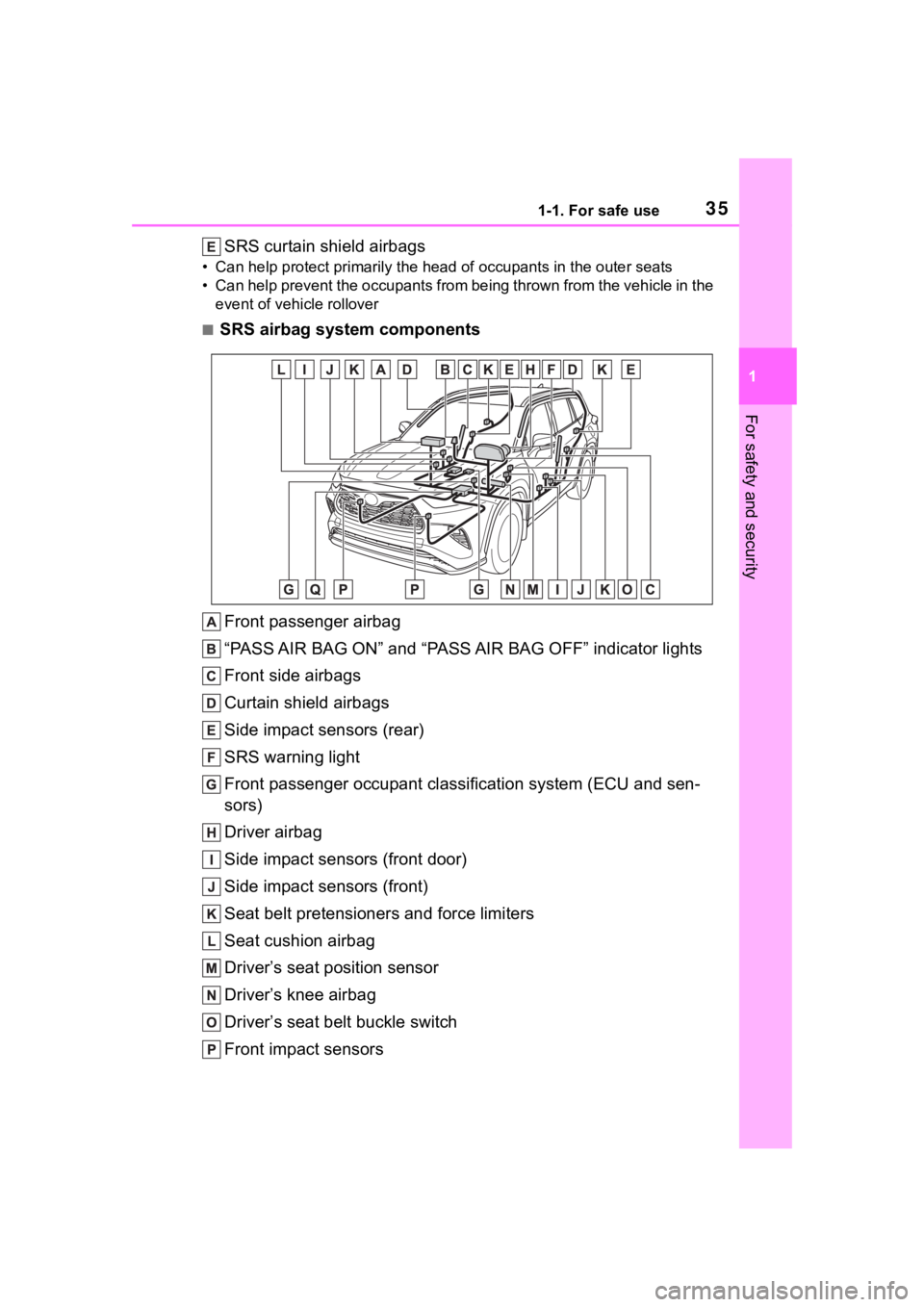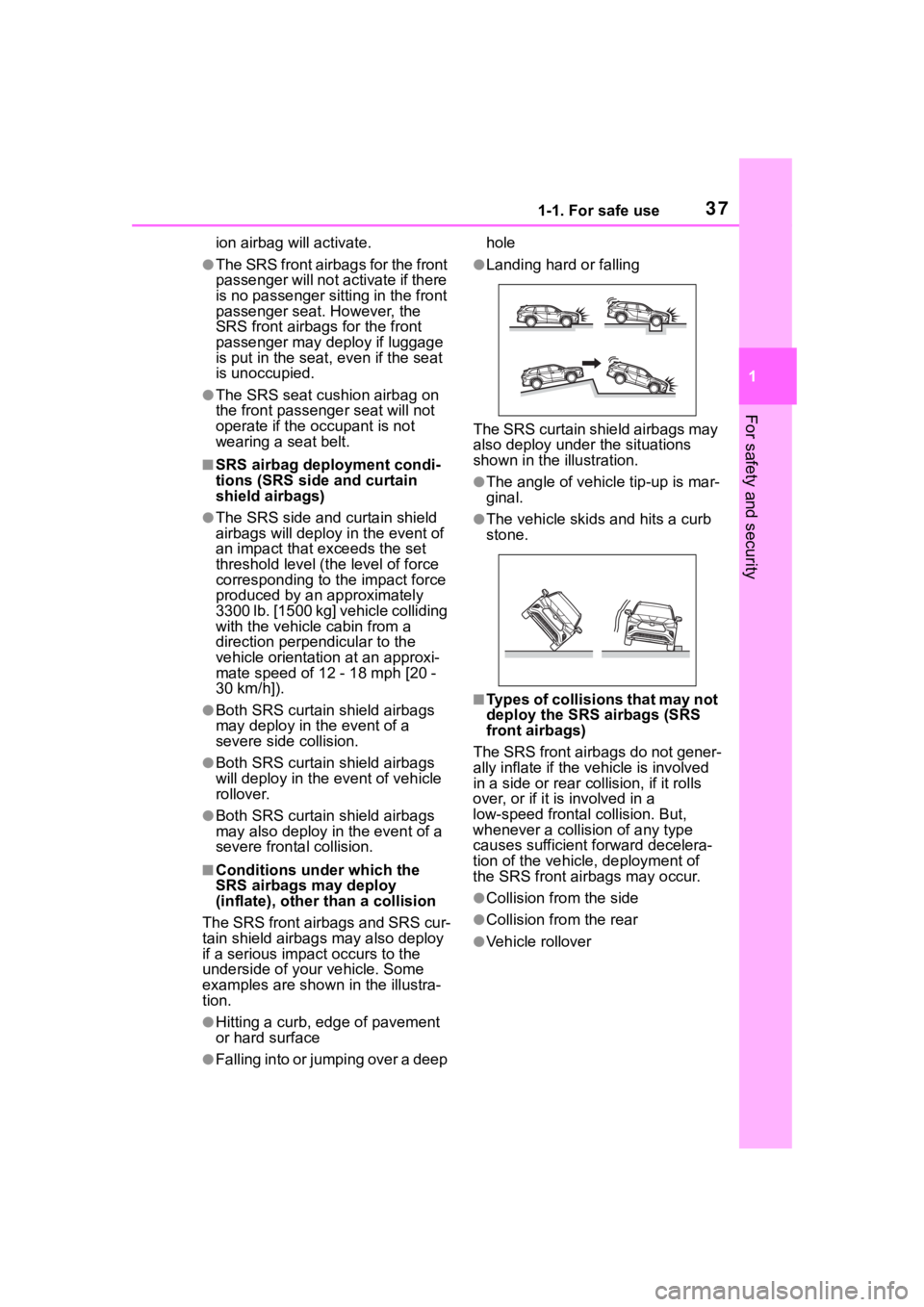shield TOYOTA HIGHLANDER HYBRID 2022 Owners Manual
[x] Cancel search | Manufacturer: TOYOTA, Model Year: 2022, Model line: HIGHLANDER HYBRID, Model: TOYOTA HIGHLANDER HYBRID 2022Pages: 572, PDF Size: 14.5 MB
Page 3 of 572

3TABLE OF CONTENTS
1
2
3
4
5
6
7
8
9
10
Parking brake .....................223
Brake Hold ......................... 226
4-3. Operating the lights and wip- ers
Headlight switch ................. 229
Automatic High Beam ........ 232
Fog light switch .................. 235
Windshield wipers and washer ......................................... 235
Rear windshield wiper and washer ............................. 238
4-4. Refueling Opening the fuel tank cap .. 240
4-5. Using the driving support sys- tems
Toyota Safety Sense 2.5 +......................................... 243
PCS (Pre-Collision System) ......................................... 249
LTA (Lane Tracing Assist)... 260
Dynamic radar cruise control with full-speed range ........ 271
RSA (Road Sign Assist) ..... 283
BSM (Blind Spot Monitor)... 286
Intuitive parking assist ........ 292
RCTA (Rear Cross Traffic Alert) function ............................ 301
PKSB (Parking Support Brake) ......................................... 308
Parking Support Brake function (static objects) .................. 315
Parking Support Brake function (rear-crossing vehicles).... 318
Driving mode select switch ......................................... 319
Trail Mode .......................... 320
Driving assist systems........ 322
4-6. Driving tips Hybrid vehicle driving tips .. 328
Winter driving tips............... 330
Utility vehicle precautions... 3335-1. Toyota multi-operation touch
Toyota multi-operation touch......................................... 338
5-2. Using the air conditioning system and defogger
Front automatic air conditioning
system ............................. 340
Rear automatic air conditioning system ............................. 352
Heated steering wheel/seat heaters/seat ventilators.... 356
5-3. Using the interior lights Interior lights list ................. 360
5-4. Using the storage features List of storage features ...... 363
Luggage compartment features ......................................... 368
5-5. Using the other interior fea- tures
Other interior features ........ 372
Garage door opener........... 388
6-1. Maintenance and care Cleaning and protecting the vehicle exterior................. 398
Cleaning and protecting the vehicle interior.................. 40
1
6-2. Maintenance
Maintenance requirements ........
................................. 404
General maintenance......... 406
Emission inspection and mainte- nance (I/M) programs ...... 408
6-3. Do-it-yourself maintenance Do-it-yourself service precau-tions ................................. 410
5Interior features
6Maintenance and care
Page 6 of 572

6
work properly or the danger that
it may work in situations where it
should not be working.
The installation of a mobile
two-way radio system in your
vehicle could affect electronic
systems such as:
Hybrid system
Multiport fuel injection sys-
tem/sequential multiport fuel
injection system
Toyota Safety Sense 2.5 +
Anti-lock brake system
SRS airbag system
Seat belt pretensioner system
Be sure to check with your Toy-
ota dealer for precautionary
measures or special instructions
regarding installation of a mobile
two-way radio system.
High voltage parts and cables
on the hybrid vehicles emit
approximately the same amount
of electromagnetic waves as the
conventional gasoline powered
vehicles or home electronic
appliances despite of their elec-
tromagnetic shielding.
Unwanted noise may occur in
the reception of the mobile
two-way radio. The vehicle is equipped with
sophisticated computers that will
record certain data, such as:
• Engine speed/Electric motor
speed (traction motor speed)
• Accelerator status
• Brake status
• Vehicle speed
• Operation status of the driving assist systems
• Images from the cameras
Your vehicle is equipped with cam-
eras. Contact your Toyota dealer for
the location of re cording cameras.
The recorded data varies
according to the vehicle grade
level and options with which it is
equipped.
These computers do not record
conversations or sounds, and
only record images outside of
the vehicle in certain situations.
Data Transmission
Your vehicle may transmit the data
recorded in these computers to
Toyota without notification to you.
Data usage
Toyota may use the data recorded
in this computer to diagnose mal-
functions, conduct research and
development, and improve quality.
Toyota will not disclose the
recorded data to a third party
except:
• With the consen t of the vehicle
owner or with the consent of the
lessee if the vehicle is leased
Installation of a mobile
two-way radio system
Vehicle data recording
Page 12 of 572

12Pictorial index
Pictorial index
■Exterior
The shape of the lights may diff er depending on the grade, etc.
Side doors ......... ................................. ................................ P.131
Locking/unlocking .............................................. .................. P.131
Opening/closing the side windows ............................... ........ P.179
Locking/unlocking by using the mechanical key .................. P. 4 9 5
Warning lights/warning messages ............................... P .464, 474
Back door ...................................................... ..................... P.135
Opening from inside the cabin
*............................................ P.137
Opening from outside........................................... ................ P.137
Warning lights/warning messages ............................... P .464, 474
Outside rear view mirrors ................................................. P.177
Adjusting the mirror angle ..................................... ............... P.177
Folding the mirrors ............................................ ................... P.178
Driving position memory
*..................................................... P.159
Defogging the mirrors .......................................... ................ P.342
Windshield wipers.............................................. ................ P.235
Page 16 of 572

16Pictorial index
When the warning messages are displayed ........................P. 4 7 4
Turn signal lever.............................................. ................... P.222
Headlight switch ............................................... ................. P.229
Headlights/side marker lights/pa rking lights/tail lights/license plate
lights/daytime running lights .................................. ............... P.229
Front fog lights ............................................... ...................... P.235
Windshield wiper and washer sw itch....................... P.235, 238
Usage.......................................................... ................. P.235, 238
Adding washer fluid .............................................................. P.418
Warning messages ............................................... ............... P.474
Emergency flasher switch ....................................... .......... P.456
Hood lock release lever ........................................ ............. P.412
Tilt and telescopic steering lock release lever ................P. 1 6 5
Adjustment ..................................................... ...................... P.165
Air conditioning system ............................. ....................... P.340
Usage................................................................................... P.340
Rear window defogger ........................................... .............. P.342
Windshield wiper de-icer
*1................................................... P.342
Audio system
*2
Fuel filler door opener swi tch ........................................... P.240
*1: If equipped
*2: Refer to “NAVIGATION AND MULTIMEDIA SYSTEM OWNER’S MAN-
UAL”.
Page 17 of 572

17Pictorial index
■Switches
Driving position memory switches*1................................ P.159
Window lock switch ............................................. .............. P.181
Power window switches ....... ............................................. P.179
Door lock switches ............................................................ P.134
Outside rear view mirror swi tches ................................... P.177
“ODO TRIP” switch .............................................. ................ P.91
Instrument panel light control switches ........................ .... P.92
Automatic High Beam switch ..................................... ...... P.232
Camera switch
*1, 2
“AC120V” switch*1............................................................. P. 382
Power back door switch ... ................................................. P.137
Heated steering wheel switch
*1........................................ P.357
Windshield wiper de-icer
*1................................................ P.350
*1: If equipped
*2: Refer to “NAVIGATI ON AND MULTIMEDIA SYSTEM OWNER’S MAN-
UAL”.
Page 34 of 572

341-1. For safe use
■Location of the SRS airbags
SRS front airbagsSRS driver airbag/front passenger airbag
Can help protect the head and chest of the driver and front passenger from
impact with interior components
SRS knee airbag
Can help provide dr iver protection
SRS seat cushion airbag
Can help restrain the front passenger
SRS side and curtain shield airbags
SRS front side airbags
Can help protect the torso of the front seat occupants
SRS airbags
The SRS airbags inflate when the vehicle is subjected to cer-
tain types of severe impacts that may cause significant injury
to the occupants. They work together with the seat belts to
help reduce the risk of death or serious injury.
SRS airbag system
Page 35 of 572

351-1. For safe use
1
For safety and security
SRS curtain shield airbags
• Can help protect primarily the head of occupants in the outer seats
• Can help prevent the occupants from being thrown from the vehi cle in the
event of vehicle rollover
■SRS airbag system components
Front passenger airbag
“PASS AIR BAG ON” and “PASS AIR BAG OFF” indicator lights
Front side airbags
Curtain shield airbags
Side impact sensors (rear)
SRS warning light
Front passenger occupant classification system (ECU and sen-
sors)
Driver airbag
Side impact sensors (front door)
Side impact sensors (front)
Seat belt pretensioners and force limiters
Seat cushion airbag
Driver’s seat position sensor
Driver’s knee airbag
Driver’s seat bel t buckle switch
Front impact sensors
Page 36 of 572

361-1. For safe use
Airbag sensor assembly
Your vehicle is equipped with ADVANCED AIRBAGS designed
based on the US motor vehicle safety standards (FMVSS208). The
airbag sensor assembly (ECU) cont rols airbag deployment based on
information obtained from the sensors etc. shown in the system
components diagram above. This in formation includes crash sever-
ity and occupant information. As the airbags deploy, a chemical
reaction in the inflators quickly fills the airbags with non-toxic gas to
help restrain the motion of the occupants.
■If the SRS airbags deploy
(inflate)
●Slight abrasions, burns, bruising
etc., may be sustained from SRS
airbags, due to the extremely high
speed deployment (inflation) by
hot gases.
●A loud noise and white powder will
be emitted.
●Parts of the airbag module (steer-
ing wheel hub, airbag cover and
inflator) as well as the front seats,
parts of the front and rear pillars,
and roof side rails, may be hot for
several minutes. T he airbag itself
may also be hot.
●The windshield may crack.
●The hybrid system will be stopped
and fuel supply to the engine will
be stopped. ( P. 7 8 )
●All of the doors will be unlocked.
( P.132)
●The brakes and st op lights will be
controlled automatically. ( P.323)
●The interior lights will turn on auto-
matically. ( P.362)
●The emergency flashers will turn
on automatically. ( P.456)
●For Safety Connect subscribers, if
any of the following situations
occur, the system is designed to
send an emergency call to the
response center, notifying them of
the vehicle’s location (without
needing to push the “SOS” button)
and an agent will attempt to speak with the occupants to ascertain
the level of emergency and assis-
tance required. If the occupants
are unable to communicate, the
agent automatically treats the call
as an emergency and helps to dis-
patch the necessary emergency
services. (
P. 6 5 )
• An SRS airbag is deployed.
• A seat belt pretensioner is acti- vated.
• The vehicle is involved in a severe rear-end collision.
■SRS airbag deployment condi-
tions (SRS front airbags)
●The SRS front airbags will deploy
in the event of an impact that
exceeds the set threshold level
(the level of forc e corresponding
to an approximately 12 - 18 mph
[20 - 30 km/h] frontal collision with
a fixed wall that does not move or
deform).
However, this threshold velocity will
be considerably higher in the follow-
ing situations:
• If the vehicle strikes an object, such as a parked vehicle or sign
pole, which can move or deform
on impact
• If the vehicle is involved in an underride collision, such as a colli-
sion in which the front of the vehi-
cle “underrides”, or goes under,
the bed of a truck
●Depending on the type of collision,
it is possible that only the seat belt
pretensioners and SRS seat cush-
Page 37 of 572

371-1. For safe use
1
For safety and security
ion airbag will activate.
●The SRS front airbags for the front
passenger will not activate if there
is no passenger sitting in the front
passenger seat. However, the
SRS front airbags for the front
passenger may de ploy if luggage
is put in the seat, even if the seat
is unoccupied.
●The SRS seat cushion airbag on
the front passen ger seat will not
operate if the occupant is not
wearing a seat belt.
■SRS airbag deployment condi-
tions (SRS side and curtain
shield airbags)
●The SRS side and curtain shield
airbags will deploy i n the event of
an impact that exceeds the set
threshold level (the level of force
corresponding to the impact force
produced by an approximately
3300 lb. [1500 kg] vehicle colliding
with the vehicle cabin from a
direction perpendicular to the
vehicle orientation at an approxi-
mate speed of 12 - 18 mph [20 -
30 km/h]).
●Both SRS curtain shield airbags
may deploy in the event of a
severe side collision.
●Both SRS curtain shield airbags
will deploy in the event of vehicle
rollover.
●Both SRS curtain shield airbags
may also deploy in the event of a
severe frontal collision.
■Conditions under which the
SRS airbags may deploy
(inflate), other t han a collision
The SRS front airbags and SRS cur-
tain shield airbags may also deploy
if a serious impact occurs to the
underside of your vehicle. Some
examples are shown in the illustra-
tion.
●Hitting a curb, edge of pavement
or hard surface
●Falling into or jumping over a deep hole
●Landing hard or falling
The SRS curtain shield airbags may
also deploy under the situations
shown in the illustration.
●The angle of vehicle tip-up is mar-
ginal.
●The vehicle skids and hits a curb
stone.
■Types of collisions that may not
deploy the SRS airbags (SRS
front airbags)
The SRS front airbags do not gener-
ally inflate if the vehicle is involved
in a side or r ear collision, if it rolls
over, or if it is involved in a
low-speed frontal collision. But,
whenever a collis ion of any type
causes sufficient forward decelera-
tion of the vehicle, deployment of
the SRS front airbags may occur.
●Collision from the side
●Collision from the rear
●Vehicle rollover
Page 38 of 572

381-1. For safe use
■Types of collisions that may not
deploy the SRS airbags (SRS
side and curtain shield airbags)
The SRS side and curtain shield air-
bags may not activate if the vehicle
is subjected to a c ollision from the
side at certain angl es, or a collision
to the side of the vehicle body other
than the passenger compartment.
●Collision from the s ide to the vehi-
cle body other than the passenger
compartment
●Collision from the s ide at an angle
The SRS side airbags do not gener-
ally inflate if the vehicle is involved
in a frontal or rear c ollision, if it rolls
over, or if it i s involved in a
low-speed side collision.
●Collision from the front
●Collision from the rear
●Vehicle rollover
The SRS curtain shield airbags do
not generally inflate if the vehicle is involved in a rear collision, if it
pitches end over en
d, or if it is
involved in a lo w-speed side or
low-speed front al collision.
●Collision from the rear
●Pitching end over end
■When to contact your Toyota
dealer
In the following ca ses, the vehicle
will require inspecti on and/or repair.
Contact your Toyota dealer as soon
as possible.
●Any of the SRS airbags have
been inflated.
●The front of the vehicle is dam-
aged or deformed, or was
involved in an accident that was
not severe enough to cause the
SRS front airbags to inflate.
●A portion of a door or its surround-
ing area is damaged, deformed or
has had a hole made in it, or the
vehicle was involved in an acci-
dent that was not severe enough
to cause the SRS side and curtain
shield airbags to inflate.